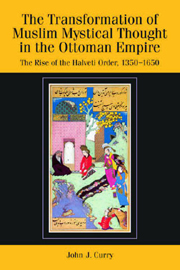 The Transformation of Muslim Mystical Thought in the Ottoman Empire
The Transformation of Muslim Mystical Thought in the Ottoman Empire from PART I - THE RISE AND SPREAD OF THE HALVETİ ORDER FROM ITS ORIGINS THROUGH THE ELEVENTH/SEVENTEENTH CENTURY
Published online by Cambridge University Press: 12 September 2012
Modern historiographical theory leads most contemporary historians to be critical of origin myths for various Sufi orders that tie them back to revered founding figures in their respective traditions. Historians recognize that the search for legitimacy in subsequent periods led all manner of Sufi intellectuals to construct narratives by which they could link themselves to irrefutable sources of authority for their community. Thus, the Halveti silsile, which all Halveti shaykhs from the earliest times up to the present would cite as an authoritative document linking themselves and their doctrines back to the founding figures of Islamic tradition, might quickly be dismissed by modern historians as having little or no historical value. At the very least, most historians of the Islamic mystical tradition now argue that what came to be called Sufism began to form, at the earliest, only during the second/eighth century, and that the consolidation of Sufi orders themselves may only have begun centuries after the first Muslims had expanded out of the Arabian peninsula.
Be that as it may, historians must also recognize that the Halveti narratives about their origins maintain a remarkable continuity over time and place when they did begin to consolidate their narrative histories and set them down in written form. Whatever lack of historical truth the Halveti silsile embodies for modern critics, it does not detract from the fact that their narratives about their foundation and origins were quite meaningful to the Halveti shaykhs and their followers, and undergirded their claims to religious legitimacy in the context of the societies they inhabited.
To save this book to your Kindle, first ensure [email protected] is added to your Approved Personal Document E-mail List under your Personal Document Settings on the Manage Your Content and Devices page of your Amazon account. Then enter the ‘name’ part of your Kindle email address below. Find out more about saving to your Kindle.
Note you can select to save to either the @free.kindle.com or @kindle.com variations. ‘@free.kindle.com’ emails are free but can only be saved to your device when it is connected to wi-fi. ‘@kindle.com’ emails can be delivered even when you are not connected to wi-fi, but note that service fees apply.
Find out more about the Kindle Personal Document Service.
To save content items to your account, please confirm that you agree to abide by our usage policies. If this is the first time you use this feature, you will be asked to authorise Cambridge Core to connect with your account. Find out more about saving content to Dropbox.
To save content items to your account, please confirm that you agree to abide by our usage policies. If this is the first time you use this feature, you will be asked to authorise Cambridge Core to connect with your account. Find out more about saving content to Google Drive.